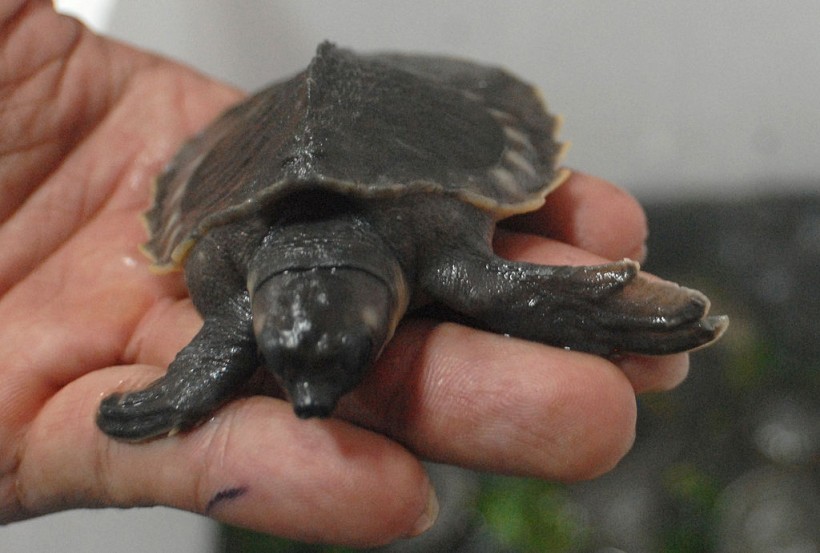Unlike most freshwater turtles, the pig-nosed turtle is nearly fully adapted to life in water, on top of its uniqueness in many respects.
A Phys.org report specified that the endangered freshwater turtle native to the Northern Territory and southern New Guinea has paddle-like flippers akin to sea turtles, a snorkel-like "pig-nose" to support its breathing as it stays submerged, and eggs that only hatch when it gets exposed to the wet season's waters.
Moreover, the discovery is also the last surviving species of a tropical turtles' group identified as "carettochelyids," which existed all over the northern hemisphere.
According to scientists, they thought pig-nosed turtles came to Australia within the last couple of millennia since no pig-nosed turtle fossils had ever been discovered there, or so many people thought.
ALSO READ: Sabre-Toothed Cat From 9 Million Years Ago Could Take Down Prey 10 Times Its Size

A Kadoorie farm employee held a baby pig-nosed turtle in Hong Kong in October 2011.
5-Million Year-Old Fossil
As indicated in the paper, published in Papers in Palaeontology, a five-million-year-old fossil from the collections of Museum Victoria has now fully rewritten this story. More so, the museum's collection for nearly a century until the researchers encountered it.
As a result, the research team was able to identify the fossil as a tiny collection of the front of the shell of a pig-nosed turtle, as reported in the paper. Even though the fossil is only a fragment, the study authors said they were fortunate that the discovery was from an extremely diagnostic site of the shell.
The fossil demonstrates that for millions of years, "carettochelyid" turtles have been living in Australia. Although, it's still a question, what a pig-nosed turtle, described in the National Aquarium site, was doing in Beaumaris five million years back, or thousands of kilometers from their contemporary range.
Previously, the weather of Melbourne was a lot warmer, not to mention wetter than it is at present. It was more similar to the tropical conditions in which such turtles exist at present.
In effect, this is not the initial prehistoric tropical species found here; monk seals, which currently live in the Mediterranean and Hawaii, and dugongs also once existed in what's now called 'Beaumaris."
A Tropical Turtle Hotspot
Millions of years back, the eastern seaboard of Australia was a tropical turtle hotspot. The warmer and water environment would have been ideal for supporting the turtles' greater diversity in the past. This, the researchers specified in the research, is in "stark to modern times," today, the country is nearly home to side-necked turtles.
Essentially, tropical turtles would have needed to cross thousands of kilometers of oceans to arrive. Nevertheless, this is not typical that small animals frequently cross the sea by hitching a ride on vegetation bundles.
The question of "Where are the turtles now?" and "Why is today's pig-nosed turtle the carettochelyids' last remaining species?" now arise.
Just like at present, animals before were endangered by climate change. When the climate of Australia turned cooler and drier following the ice ages, all the tropical turtles had gone extinct, except for the pig-nosed turtle in the New Guinea and Northern Territory.
This proposes, too, that the modern-day pig-nosed turtle, already threatened, is under threat from climate change that humans drive. Such turtles are extremely sensitive to the environment, and minus rain, their eggs don't have the ability to hatch.
This is true of the native animals and plants of Australia. In reptile species like turtles and crocodiles, gender can be identified by the temperature at which eggs are incubated. This is yet another factor that could put such species at risk for climate change.
Related information about the fossil discovery is shown on NewsRme's YouTube video below:
RELATED ARTICLE: Coelacanths: Four-Legged "Living Fossil" Fish Found in Madagascar
Check out more news and information on Paleontology in Science Times.














